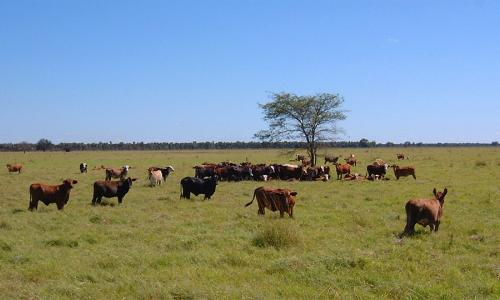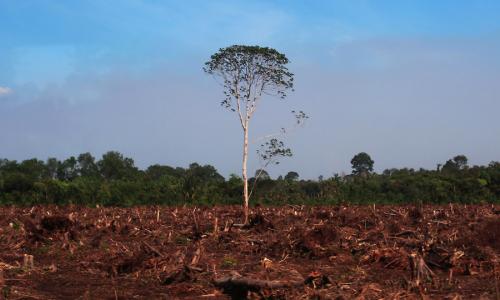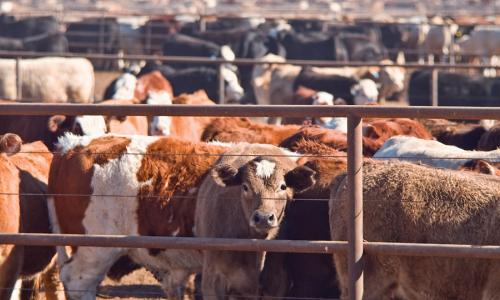"Beef. It's what's for dinner," according to a classic marketing campaign. Whether or not this is true in your home, beef is definitely the main course on the global deforestation menu.
While many commodities are driving deforestation today, all of them take a back seat to beef cattle. It's old news that beef is the biggest deforestation driver in Latin America, but recent research suggests that it's also #1 globally.
In the countries that account for most of the deforestation caused by the four major drivers, beef is responsible for more than twice as much deforestation as the other three commodities combined. When we measure the global warming emissions caused by deforestation, rather than land area, beef's role looks slightly smaller, because the forests cleared for palm oil and wood products in Southeast Asia tend to be more carbon-rich and therefore produce more emissions per unit of area. But even in terms of emissions, beef contributes the largest percentage of the four.
In South America, the numbers emphasize beef's predominance even more starkly: beef was responsible for 71% of total deforestation in South America between 1990 and 2005, versus just over 17% for all other agricultural drivers combined—including soybeans.
Cattle and deforestation: it's complicated
Looking at a map of global cattle distribution (below) might lead you to assume that beef is a major deforestation driver on every continent. This isn't the case for two reasons. First, not all domestic cattle are raised for beef; in many parts of the world, such as India—home to the world's largest cattle population—most cattle are used for dairy or as work animals. Cattle raised for these uses play little role in deforestation.
And in much of the world, beef cattle are raised in regions that are not heavily forested, such as the savannas of sub-Saharan Africa or the high plains of North America. In these places, beef is a major product but not a major deforestation driver. (This does not mean that beef produced in these regions has no global warming impact: the digestive systems of cattle emit large amounts of methane and nitrous oxide—powerful global warming pollutants—no matter what kind of land they occupy. And beef producers may import feed, such as soybeans, from countries where that feed is a deforestation driver—so it's possible for beef to drive deforestation indirectly even in countries where it does not do so directly.)
Most of the deforestation impact of current beef production is concentrated in Latin America:
Produced globally, consumed locally
Beef differs from other major deforestation drivers in one important respect: it is most often eaten in the same country that produced it. There are exceptions, such as Paraguay, which became a major beef producer only recently and exports the majority of its beef. But in most beef-producing countries, a high percentage of domestically produced beef is also consumed domestically.
The world average for beef consumption is 6.6 kilograms (about 15 pounds) per person per year. But in the largest beef-consuming countries, such as the United States and Brazil, the average is about four times that much, or roughly a pound per person per week.
Big carbon bang, small nutritional buck
In most existing systems, beef is a highly inefficient way to convert the sun's energy into food. This is true even compared to other animal products such as pork, poultry and dairy, and far more so compared to plant foods. While beef can be produced in well-managed grasslands and rangelands with greater efficiency, and with benefits including soil carbon sequestration, such systems remain rare.
This nutritional inefficiency magnifies the high carbon footprint of typical beef production. On a per-calorie basis, beef produced in tropical regions is responsible for nearly 200 times as much global warming emissions as soy, and over 60 times as much as palm oil:
The inefficiency of most current beef production has other implications. For consumers, it means that beef is more expensive than most other foods: from 2010 to 2014 the average price per ton of beef was more than 4 times that of poultry meat and 17 times that of wheat. (It tends to be expensive for the planet, too, and not just in terms of carbon emissions: the cost in resource depletion or "natural capital" per ton of beef ranges from 6 to 34 times that of pork, poultry, dairy, and plant-based foods.) For producers, it typically means that beef has a low economic return per unit of land compared to other major deforestation drivers.
But this inefficiency also represents an opportunity: it means that we could substantially reduce the amount of land used for beef with very little sacrifice of food. In fact, food security and even overall meat supply could be increased by shifts away from beef to more land-efficient alternatives.
Reducing beef-driven deforestation
Can beef's outsized deforestation impact be reduced?
Low stocking rates in Latin America have led to the idea that intensification of beef production—higher densities, improved pastures, perhaps supplemental feeds—might have a positive effect. But this is not as straightforward a solution as it seems. Land in the Amazon is more valuable after it has been cleared, so cattle are often used to claim ownership of land before it is sold for profit rather than for the purpose of raising cattle. Ranchers who are more focused on land speculation than beef production might not see much benefit to reducing their land use through intensification. Therefore, reducing demand for beef produced in these areas may need to be combined with additional measures that reduce other drivers of deforestation in order to be effective.
But as with other commodities, beef production does not have to equal deforestation. The beef moratorium in Brazil shows how public pressure for zero-deforestation commitments can dramatically transform the supply chain. Responding to campaigning by non-governmental organizations (NGOs), the major meatpackers in Brazil adopted a moratorium in mid-2009, pledging not to buy from ranches responsible for deforestation. Strong enforcement of these commitments was a key element. The moratorium has led to important changes in the actions of ranchers, and it is one of the most important reasons why Amazon deforestation in Brazil dropped by 70% from 2005 to 2014.
It's also possible to reduce the overall global warming impact of beef through best management practices for pasture and rangelands, which promote soil carbon sequestration and provide other environmental and socioeconomic benefits. Such systems are currently very rare, and encouraging their wider adoption could help to offset beef's role as a deforestation driver.






